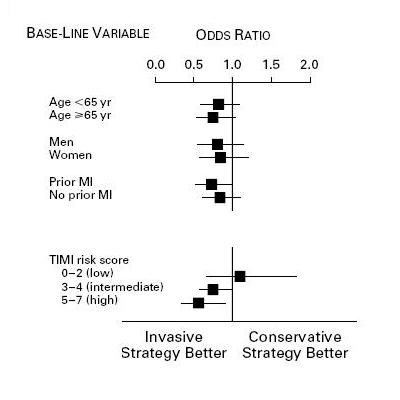In this month's Health Affairs, Drs. Rodney Hayward, David Kent, Sandeep Vijan, and Timothy Hofer proposed that the analysis of benefits and risks in RCTs should always include a component in which patients with high risks are analyzed separately from those at low risks. That is to say, in making health policy decisions, we need to know the individual differences in the risk-vs-benefit balance at baseline and present our findings accordingly. For instance, whether or not a medication like Vioxx should be given to a patient will depend on his/her pre-existing risk of developing stomach ulcers. RCTs on Vioxx then should include subgroup analysis that investigate the its effect on high ulcer risk patients and low ulcer risk patients separately.
However,
The main results of clinical trials are presented as the average benefit across all people in the trial. ... [Risk-stratified analysis] could overcome some of the limitations inherent in conventional approaches to analyzing and reporting clinical trials.
With respect to what do we stratify our patients?
Multivariable risk prediction models/tools use statistical formulas that estimate individual risk based on combining information from multiple independent risk factors.(For example, APACHE to predict mortality in critically ill patients, APGAR to predict risk of adverse outcomes in neonates, and BODE to predict 1-year mortality of patients with COPD.)
Finally, the meat of the article is a review of recent RCTs to see how prevalent is such stratified analysis in RCTs. Hayward et al studied the subset of all RCTs published in the year 2001 in major medical journals (JAMA, NEJM, and Lancet) which used as primary endpoints mortality or major morbidity. Of these 108 RCTs, 42 (39%) did not report subgroup analysis. Only 4 (4%) studies performed risk-stratified analysis, and of these only 1 used statistically robust methods.
As an example of the risk-stratified analysis they have in mind, they point to this
RCT comparing early invasive intervention vs conventional intervention in patients presenting with acute coronary syndrome (Cannon et al 2001).

In this figure, abstracted from the article's Figure 2, multiple stratified analyses are shown. Those on top are "single-variable stratifications", each based on an individual variable (in this case age, gender, history of prior MI). The bottom analysis is Hayward et al's risk-stratified analysis, in this case with respect to TIMI score for unstable angina/non-ST elevation myocardial infarction. This figure makes clear that according to this RCT, early revascularization is benefitial only in those with high risk for adverse cardiac outcomes. It is Hayward et al's thesis that such stratified analyses facilitate decision-making by patients, healthcare providers, insurance companies, and regulatory agencies.
Finally, they propose that CONSORT incorporate risk-stratified analyses in irs RCT guidelines, that the FDA mandate the use of risk-stratified analyses in RCTs, and--given such individualized estimates of expected risks vs benefits--
We propose ... intermediate steps for our policy decisions. For example, instead of deciding whether coverage of a treatment should be zero or 100 percent, we could adjust copayments based on the amount of expected benefit (instead of basing copayments on the cost of treatment alone).
Technorati Tags:
medicine statistics clinical trials risk-stratification



3 comments:
Could you explain how risk stratified analysis avoid the problem(s) of post hoc sub group analysis namely the multi-comparison problem of false positives and reduced power of the subgroup(s) to show a real difference.
Hi Dr. Gaulte, please see my new post today. http://wnlreason.blogspot.com/2005/11/subgroup-analysis-and-post-hoc.html#links
Thanks for reading!
Thanks for taking the effort to give a thoughtful reply.
Post a Comment